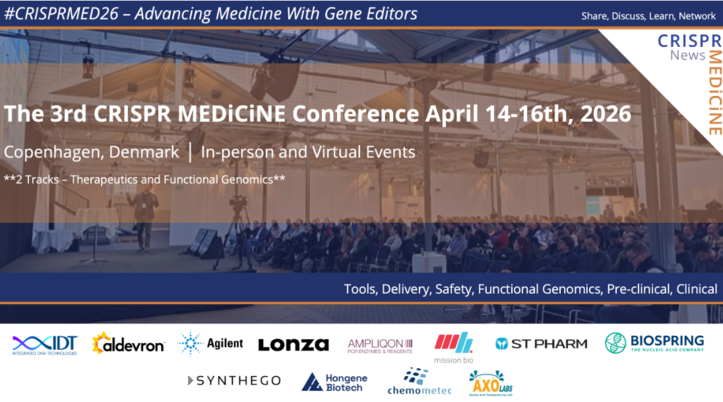CRISPR Medicine News Interview with Scribe Therapeutics CEO, Benjamin Oakes

- Scribe Therapeutics spun out of Jennifer Doudna’s lab at UC Berkeley in 2018. You are one of the founders, along with Brett Staahl, David Savage, and Jennifer Doudna herself. Can you tell me how you ended up working in this area?
I actually started out studying to be a medical doctor. But in shadowing doctors in rural Maine, I quickly realised that most of medicine wasn't focused on treating the underlying causes of disease. It still isn't today, and that's not a problem with medicine, but more a problem with not having the tools to do so. This really motivated my transition from wanting to be a doctor or an MD with a PhD, to wanting to build those missing tools. And that became my new goal. I knew that trying to build the necessary technical skills would be crucial, so rather than going straight into graduate school, I joined Marcus Noyes’ lab at Princeton University that focused on engineering zinc finger nucleases. For two years I built huge unbiased libraries of zinc finger nucleases.
- And then Jennifer Doudna and Emmanuelle Charpentier published that seminal paper on CRISPR-Cas9 in 2012, right?
Yes! We had been working 80-hour weeks for 2 years trying to develop a code that could figure out how to bind zinc finger targets so that we could target any location in the genome. And then CRISPR-Cas9 emerged and suddenly I was free to target anything I wanted. I realised that this was the perfect time for me to start graduate school and I joined Jennifer’s lab to conduct my PhD, under the co-supervision of David Savage, who is also a co-founder of Scribe.
- So you now had the CRISPR-Cas9 technology at your disposal starting out as a PhD student. What did you do with it?
Together with the lab, I set out on a series of engineering journeys for Cas9 to understand this molecule better and create derivatives with enhanced functions. We developed topological mutagenesis techniques for many different outcomes, including domain insertions and deletions, and circular permutation to reorganise the ordering of the amino acid sequence. This allowed us to create Cas9 switches that could turn on or off in response to small molecules, or even sense the presence of other proteins in the cell. I did this work jointly between David Savage and Jennifer Doudna, and when I graduated in 2017, we sat down for a serious discussion about what we were doing, what was needed at the time, and what was needed to enable the next 20 years of genetic medicine. We envisioned that genetic medicine will by and large be in vivo, and in the ideal world we would be able to get to the cells that matter the most for each specific disease.
- Was that the starting point for Scribe Therapeutics?
Yes, David Savage, Jennifer Doudna, Brett Staahl, and I had been working on CRISPR-Cas9 from 2013 to 2017 and we realised that there were some key limitations that couldn’t be solved with Cas9 for a number of structural and pragmatic reasons. So we founded Scribe with 4 specific goals: 1) to improve efficacy, 2) to improve specificity, 3) to develop tools for in vivo delivery, and 4) to build technologies that we could use in the ways we saw fit.
- Many companies and research labs are trying to do all of these things you mention. What makes Scribe different?
With Cas9, new derivatives have been engineered with improved efficacy and others with improved specificity. There is currently no one CRISPR platform that ticks all of the boxes. As expert molecular engineers, our approach was to find the right ‘clay’ that we could then shape into a set of technologies that has all these desirable characteristics.
-Ok, so a different Cas endonuclease then?
Yes. Jennifer Doudna had been continually working with Jill Banfield at UC Berkeley to find new and distinct CRISPR proteins, and we had access to a couple of them. I started my own lab at the Innovative Genomics Institute in 2017 to test some of these enzymes and figure out if any of them might be this clay we were looking for to shape into the ideal genome-editing modality. About a year and a half in, we settled on the newly-discovered CasX. It was ideal in many ways – smaller than Cas9, didn’t originate from human pathogens, yet had the RNA-guided programmable double stranded DNA binding nature of Cas9 that we wanted.
- And you got investment to go forward with CasX?
We secured our first round of capital with Andreessen Horowitz in late 2018, based on the premise that we would completely redesign CasX to incorporate all of the characteristics into a single complete platform with our molecular engineering machine (our expertise) at our core. We have access to other molecules besides CasX but the idea is the same, to apply continuous and iterative step-wise changes to the Cas molecule until we have what we want. And in my mind, once you have a programmable RNA-guided DNA-binding tool, there's no reason to get another. What you need is to engineer that tool to be the very best.
- Couldn’t this same strategy have been applied to Cas9, then? And what is Scribe doing that is so different to all the others in the field?
Theoretically, yes. It might be possible with several Cas proteins but protein engineering is incredibly difficult and what Scribe is doing is more than random mutagenesis. We are actually comprehensively making every change needed to a protein without compromising on any single parameter along the way. Our deep knowledge has led us to engineer proteins in ways that others either haven’t thought about or don’t have the know-how to do. I guess that is what you might call our secret sauce. We can now build a very diverse libraries of Cas molecules, select for a number of desired characteristics from tens of millions of choices, then take the thousands of potential hits and winnow them down to the top few. This is how we developed our core technology around CasX, which is XE technology (XE = X editing).
- Ok, and where are you now with the company and with the technology?
Right now, we are a team of just under 25 staff. We’ve reached the point where our XE enzymes are more specific, more efficient and more deliverable than the Cas9s currently being used in vivo in the clinic. And we are continuing to improve our molecules all the time to push for better and more diverse activities. Our technology is now at the point that we can build in vivo therapeutics with Biogen, who are one of the best players in the neuroscience field.
- CRISPR Medicine News has interviewed many researchers working on ‘the CRISPR delivery challenge’ and we haven’t yet come across a delivery strategy for the brain. How are you addressing delivery for neurological diseases?
Blood brain barrier penetration is still a very open question in medicine apart from success stories with a few small molecules. We are looking at delivery routes in collaboration with Biogen, and based on the work of giants who’ve come before us in genetic medicine, specifically within the RNAi field, we see intrathecal delivery i.e. into the spinal canal as one possibility. This is obviously less invasive than injection directly into the brain.
- And the partnership with Biogen is for Amyotrophic lateral sclerosis (ALS). Is intrathecal delivery working in mouse models of ALS?
We have tried many delivery routes and we are getting good results with adeno-associated viral (AAV) delivery but we are also working on developing our own non-viral delivery technologies in house. We envision delivering a CRISPR biologic or a protein that can get into the right cells and tissues to modify the genome, and then degrade very rapidly as every protein does. Brett Staahl has worked extensively on CRISPR delivery since 2013 and has succeeded in doing this in mouse models. His work in Jennifer's lab demonstrated the ability to make specific edits in mouse brains in vivo using locally-administered Cas9 ribonucleoproteins. By engineering Cas9 to carry multiple N-terminal SV40* nuclear localisation sequences, the lab saw a remarkable increase in the efficiency of neuronal editing in vivo. This is some of the expertise and technology that Scribe is building on with our XE enzymes.
*Nuclear localisation sequences from simian virus 40 (SV40) have been found to boost the innate cell penetrating capabilities of zinc finger nucleases and Cas ribonucleproteins.
- Do you really believe that Scribe can develop one brilliant Cas enzyme that can do everything for all diseases? Or will there likely be a toolbox for different diseases, delivery routes, etc.?
Yes, I think we can do it - I think we have. But, look at our predecessor companies such as the zinc finger players, who believe it's worth engineering for six months to get the ideal genome targeting enzyme for a single therapeutic. And I happen to agree. So while we’re not planning to deviate from our RNA-guided programmable XE technology, which has the ability to target autosomal dominant negative diseases, we are very open to developing enzymes with special characteristics that may for instance address additional diseases.
- And that brings me to my last few questions. Scribe seems to have interest in many diverse disease areas. Are you working on all of these areas?
We are working on some of them and thinking about a lot of them. We are open to working with other companies to bring our unique technology forward into breakthrough gene editing therapies. Our in-house pipeline is focused on treating diseases in vivo.
- And what does your in-house pipeline look like?
We’re not disclosing our own pipeline at this minute but we’ve thought about the parts of the body that are hard to take out and edit and areas with unmet need. And when we think about this we can also reflect on where genetic medicine has made a large impact. Spinal muscular atrophy or SMA is a good example of a group of diseases for which a few genetic medicines have already succeeded. These therapeutics tackle the underlying cause of disease to transform patient’s lives and this is deeply motivating. The research community is also beginning to really understand the mechanisms of some of these diseases too so for us these examples are a clear place to start.
- Finally the million dollar question, when do you expect to be in the clinic?
I think one thing we have learned from our predecessors is to be humble about timelines to the clinic, because it’s so difficult, especially with these newer technologies. I don't want Scribe to be in a situation we've seen some other companies get into, which is, oh, it's coming. It's coming. Our goal is to be realistic and pragmatic as we are doing everything we can to speed these therapies to the clinic.
Tags
ArticleInterviewDeliveryNon-viralGene therapyCRISPR-CasCas9CasX
CLINICAL TRIALS
Sponsors:
Suzhou Maximum Bio-tech Co., Ltd.
Sponsors:
Zhejiang University







